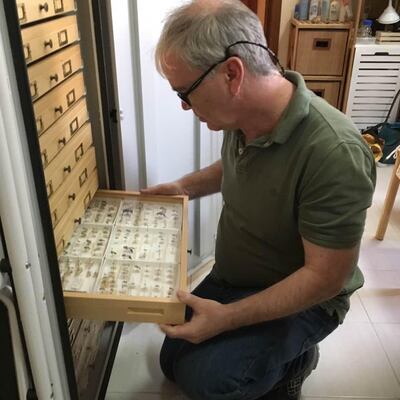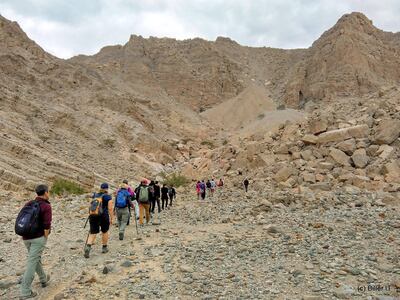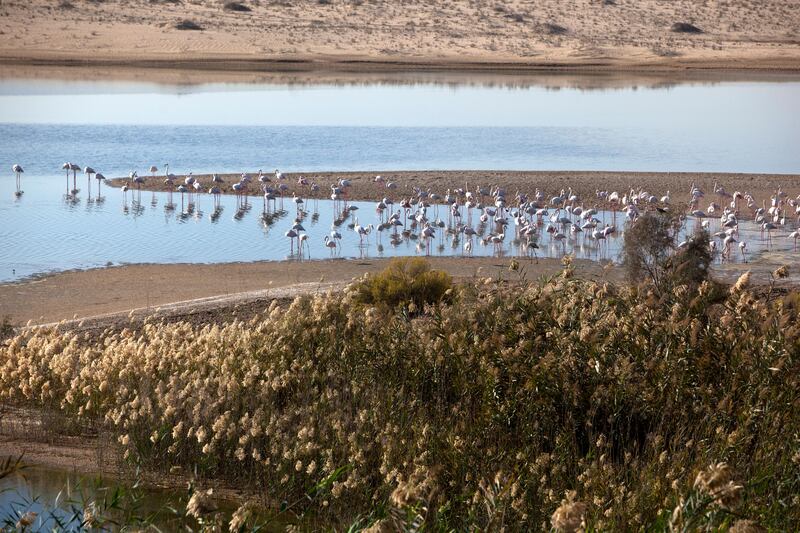Somewhere under a skyscraper in Khalidiya is a large collection of dugong skulls. The skulls were buried there 40 years ago by Anthony Harris who had bought them from the local fish market for visiting scientists from Cambridge.
The marine biologists wanted to measure the skulls to learn about the local dugong population, but in order the skulls had to be dried first.
Harris, then second in command at the British embassy, obliged the visitors by burying the big, bloody heads in his sandy garden. There was just one problem.
“It wasn’t going as we planned because the soil in which we buried them was extremely salty, and I think that did more to preserve them rather than to decay,” recalls Harris. “We had wanted some nice clean bones.”
Before the skulls were ready, Harris and his wife were sent to Geneva. When he returned to the house years later, it had been bulldozed for an urban development. The skulls remain buried to this day, somewhere not far from the Hilton Hotel.
This was the beginning of the Emirates Natural History Group, a collection of ambassadors and teachers, oilmen and homemakers, who roamed deserts and wadis collecting specimens of flora and fauna, loving sabkha salt flats and wadi vistas in equal measure.
Their observations were some of the first recordings of the UAE’s natural history and helped to lead to the establishment of nature reserves, the recognition of new species for the country and the discovery of significant archaeological sites like the 1,400 year old Christian monastery at Sir Bani Yas.
The talk the scientists gave to a small group of expatriates in 1977 was considered by some to be the group’s first official meeting. Ever since, naturalists from Abu Dhabi have gathered on the second and fourth Tuesday of each month, from September to June.
On September 12, Peter Hellyer will give a talk on the group's 40-year history at the Park Hyatt Hotel.
Hellyer, a committee member since 1985 and former chair, will discuss a “collection of events” with the group’s current chair, Arabella Willing.
“Back in the late 70s and the early 80s there wasn’t a lot else going on,” says Hellyer. “Because there wasn’t much else to do, people came along. For new arrivals in Abu Dhabi it provided a way to meet people. There were teachers, company people, diplomats, all sorts. So it grew because of that.”
Much of the appeal in the group’s early days was the ability to explore and document the country’s wildlife, great and small, for the first time.
_____________________
Read more:
[ Small-scale philanthropic initiatives do make a world of difference ]
[ Why the UAE needs to invest more in environmental research institutions ]
[ How citizen scientists can give a little and learn a lot ]
_____________________
“It is probably difficult for people arriving in the UAE in the current millennium – seeing a land of fences, privatised land, increasing border restrictions, pervasive coastal development and protected areas – to appreciate how open and accessible the country was in earlier years, and what an unexpected and unsung paradise it was in earlier years,” says Gary Feulner, the chair of the Dubai chapter and a longstanding member.
Harris remembers traveling through Liwa, finding traces of ostrich shells and stone artifacts. His then-wife, Patricia, recorded the plants that could survive in one of the Earth’s harshest terrains.
“It all came about the way these things do,” says Harris, who moved back to the UAE years later to serve as ambassador.
“It started in a conversation over a meal and we decided to set it up. Back in the day, it was people discovering new species and really learning about the nature for the first time.”
Such explorations produced some of the country’s earliest records, initially collected in a database on cards and bits of paper. “Before that, you’d get people who would come in and out and of the country and records were lost in somebody’s cupboards in the UK or America or somewhere else,” says Hellyer. “The Group was the first place locally where records were kept.”
Early on, founding member JNB “Bish” Brown encouraged amateur enthusiasts to send specimens to overseas for identification.

Brown, an ADMA-OPCO employee who had been a Second World War Spitfire pilot, connected the group with the Royal Horticultural Society at Kew Gardens and the Natural History Museum in London.
“They would identify things for us and from here, we would help them to expand their knowledge,” says Hellyer. “For example, a new species of ant was discovered in the 1970s by someone working at the British embassy. People would just wander around the desert and collect ants and they’d send the dead ants to the museum.”
Harris made use of his work at the embassy to find speakers for the group’s talks. Past speakers include two of the great explorers of the 20th century - the Norwegian explorer Thor Heyerdahl, who led the 1947 Kon-Tiki expedition, and the British explorer Sir Wilfred Thesiger, who crossed the Empty Quarter twice in 1946 and 1947.
There were also local scientists like geologist like Graham Evans, the founder of the study of the sabkha salt flats, who spend his honeymoon researching the sabkhas of Abu Dhabi in 1962.
The group began a regular bulletin in 1978, and started the peer-reviewed journal Tribulus in 1991. A winter 1997 issue is typical in flavour and scope of the publication.
Articles include A preliminary note on ceramics from the island of Qarnein, Observations in a Dhub colony (noting that Dhub lizard populations explode after a heavy rain) and Hyena sitings? (addressing whether or not the striped hyena, Hyaena hyaena, may be extinct in the Emirates).
Sheikh Nahyan bin Mubarak, Minister of Culture, Youth and Community Development, became the group’s patron more than 30 years ago. He praised the group for promoting a wider understanding of the natural history and heritage of the whole of the Emirates.
"They have done this through their regular public meetings, through dedicated fieldwork and research and through their publications, while many of the ENHG's active members have made a substantial contribution over many years to our knowledge of our environment and all that it contains," Sheikh Nayhan said in a statement to The National. "In so doing, group members have played an important part in promoting the philosophy of environmental conservation that now forms a key element of Government policies and practices."

From the original Abu Dhabi group, there are now branches in Dubai and Al Ain under the patronage of Sheikh Nahyan and a Fujairah branch under the patronage of the Crown Prince of Fujairah, Sheikh Mohammad bin Hamad.
A branch in Ras Al Khaimah started this year. “It was always our intention that this was for real, that it would grow into something,” says Harris, who still lives in Dubai. “Mighty oaks from little acorns grow.”
Nowadays, the group focuses on promoting research and conservation. This includes two annual awards, the Sheikh Mubarak bin Mohammed Award for Natural History, and the Bish Brown Award, named for the late founding member.
“Just being engaged with nature in general is something that everyone craves,” says Willing, a marine biologist at the Park Hyatt at Saadiyat. “It’s just a community of people who like to be outside and those are the best kind of people.”
Current members assist with local research, like the UAE Dolphin Project where trained volunteers strategically monitor the seas from Saadiyat Island to collect data.
Last year, members travelled to the former pearling village of Jazirat Al Hamra in Ras Al Khaimah to survey the coral used in old buildings for a study of the Gulf’s marine history conducted by Dr John Burt.
“If you’re in the UK or Canada or the States, you’re not going to find an archaeological site that nobody else has found before,” says Hellyer. “It’s really difficult to add a new species to a country’s bird list or a breeding species or to identify a plant that’s new to science.
“But here there are discoveries to be made every day, all the time, and you have the challenge of finding something new. You’re adding something to the sum of human knowledge. It may not be something very significant but there’s still an excitement about the discovery."
Lectures are free and open to the public. Membership costs Dh100 per annum.





